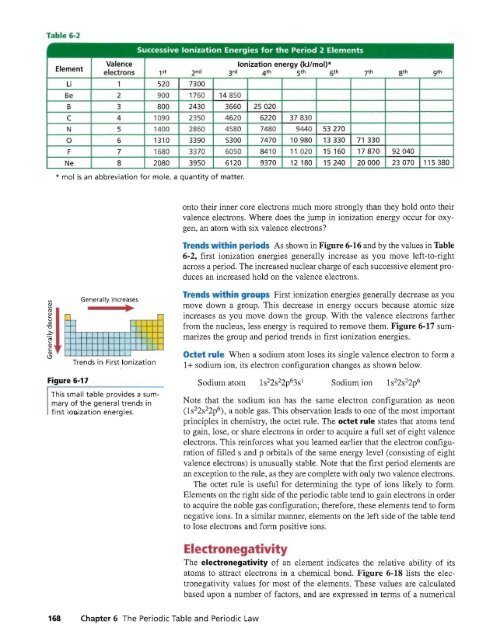Chapter 6
Chapter 6
Chapter 6
Create successful ePaper yourself
Turn your PDF publications into a flip-book with our unique Google optimized e-Paper software.
-<br />
Successive Ionization Energies for the Period 2 Elements<br />
Element<br />
Valence<br />
Ionization energy (kJ/mol)*<br />
,electrons 1S t 2 nd 3 rd 4 th 5 th 6 th 7 th 8 th 9 th<br />
Li 1 520 7300<br />
Be 2 900 176Q 14850<br />
B 3 800 2430 3660 25020<br />
C 4 1090 2.350 4620 6220 37830<br />
N 5 1400 2850 4580 748(J 9440 53270<br />
0 6 1310 3390 5300 7470 10980 13330 71 330<br />
F 7 1680 3370 6050 8410 11020 15 160 17870 92040<br />
Ne 8 2080 3950 6120 9370 12 180 15240 20000 23070 115 380<br />
* mol is an abbreviation for mole, a quantity of matter.<br />
onto their inner core electrons much more strongly than they hold onto their<br />
valence electrons. Where does the jump in ionization energy occur for oxygen,<br />
an atom with six valence electrons<br />
Tre ds -:thin periods As shown in Figure 6-16 and by the values in Table<br />
6-2, first ionization energies generally increase as you move left-to-right<br />
across a period. The increased nuclear charge of each successive element produces<br />
an increased hold on the valence electrons.<br />
Generally increases<br />
I I I<br />
_J<br />
Trends in First Ionization<br />
Trends - hiD _'ups First ionization energies generally decrease as you<br />
move down a group. This decrease in energy occurs because atomic size<br />
increases as you move down the group. With the valence electrons farther<br />
from the nucleus, less energy is required to remove them. Figure 6-17 summarizes<br />
the group and period trends in first ionization energies.<br />
Octet ru e When a sodium atom loses its single valence electron to form a<br />
1+ sodium ion, its electron configuration changes as shown below.<br />
Figure 6-11 Sodium atom Sodium ion<br />
This small table provides a summary<br />
of the general trends in<br />
first iOQization energies.<br />
Note that the sodium ion has the same electron configuration as neon<br />
(ls 2 2s 2 2p6), a noble gas. This observation leads to one of the most important<br />
principles in chemistry, the octet rule. The octet rule states that atoms tend<br />
to gain, lose, or share electrons in order to acquire a full set of eight valence<br />
electrons. This reinforces what you learned earlier that the electron configuration<br />
of filled sand p orbitals of the same energy level (consisting of eight<br />
valence electrons) is unusually stable. Note that the first period elements are<br />
an exception to the rule, as they are complete with only two valence electrons.<br />
The octet rule is useful for determining the type of ions likely to form.<br />
Elements on the right side of the periodic table tend to gain electrons in order<br />
to acquire the noble gas configuration; therefore, these elements tend to form<br />
negative ions. In a similar manner, elements on the left side of the table tend<br />
to lose electrons and form positive ions.<br />
lectro egat<br />
i y<br />
The electronegativity of an element indicates the relative ability of its<br />
atoms to attract electrons in a chemical bond. Figure 6-18 lists the electronegativity<br />
values for most of the elements. These values are calculated<br />
based upon a number of factors, and are expressed in terms of a numerical<br />
168 <strong>Chapter</strong> 6 The Periodic Table and Periodic Law












